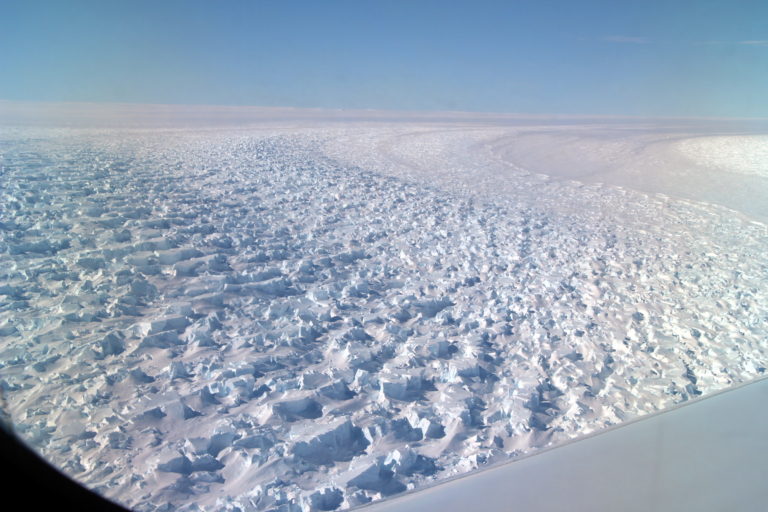23 March 2020

Researchers are concerned that the unique topography beneath East Antarctica’s Denman Glacier could make it even more susceptible to climate-driven collapse.
Credit: NASA.
AGU press contact:
Lauren Lipuma, +1 (202) 777-7396, [email protected]
Contact information for the researchers:
Virginia Brancato, NASA Jet Propulsion Laboratory, [email protected]
WASHINGTON—East Antarctica’s Denman Glacier has retreated 5 kilometers, nearly 3 miles, in the past 22 years, and researchers at the University of California, Irvine and NASA’s Jet Propulsion Laboratory are concerned that the shape of the ground surface beneath the ice sheet could make it even more susceptible to climate-driven collapse.
If fully thawed, the ice in Denman would cause sea levels worldwide to rise about 1.5 meters, almost 5 feet. Scientists have recently completed the most thorough examination yet of the glacier and surrounding area to date, uncovering alarming clues about its condition under further global warming.
The team’s results are published today in AGU’s journal Geophysical Research Letters.
“East Antarctica has long been thought to be less threatened, but as glaciers such as Denman have come under closer scrutiny by the cryosphere science community, we are now beginning to see evidence of potential marine ice sheet instability in this region,” said Eric Rignot, Chancellor’s Professor of Earth system science at UCI and co-author of the new study.
“The ice in West Antarctica has been melting faster in recent years, but the sheer size of Denman Glacier means that its potential impact on long-term sea level rise is just as significant,” he added.
According to the study, Denman Glacier experienced a cumulative mass loss of 268 billion tons of ice between 1979 and 2017.
Using radar interferometer data from the Italian Space Agency’s COSMO-SkyMed satellite system, the researchers more precisely determined Denman’s grounding line, the point at which the ice leaves the land and begins to float in the ocean.
“Differential synthetic aperture radar interferometer data from 1996 to 2018 showed us a marked asymmetry in the grounding line retreat at the ice sheet’s land-sea interface,” said lead author Virginia Brancato, a postdoctoral fellow with NASA JPL who was a postdoctoral scholar at UCI when the study was conducted.
Denman’s eastern flank is protected from retreat by a subglacial ridge. But Brancato said that the western flank, which extends roughly 4 kilometers, is characterized by a deep and steep trough with a bed slope conducive to accelerated retreat.
“Because of the shape of the ground beneath Denman’s western side, there is potential for rapid and irreversible retreat, and that means substantial increases in global sea levels in the future,” she said.
In December, Nature Geoscience published a paper on the BedMachine Antarctica project led by Mathieu Morlighem, UCI associate professor of Earth system science, which revealed that the trough beneath Denman Glacier extends 3,500 meters below sea level, making it the deepest land canyon on Earth.
The UCI and NASA JPL scientists report in the Geophysical Research Letters paper that the bed configuration of Denman is unique in Antarctica’s eastern sector. Other major glaciers, such as Totten and Moscow University, feature prograde beds that slope down in the flow direction, providing some measure of stability, Rignot said.
Tracking the state of the floating extension of Denman Glacier, a 24,000-square-kilometer mass that includes the Shackleton Ice Shelf and Denman ice tongue, will be especially important, he added. The researchers used the German Aerospace Center’s TanDEM-X satellite in combination with data from COSMO-SkyMed to assess the melt rate of the floating sea ice, learning that the Denman ice tongue has shed mass at a rate of about 3 meters per year, above average compared to other East Antarctic ice shelves.
“We need to collect oceanographic data near Denman and keep an eye on its grounding line,” Rignot said. “The Italian COSMO-SkyMed satellite system is the only tool for us to monitor grounding line conditions in this sector of Antarctica, and we are fortunate to have on our team Dr. Brancato, who is skilled in extrapolating the data to give us the precise and up-to-date information we require.”
###
AGU (www.agu.org) is an international association of more than 60,000 advocates and experts in Earth and space science. Through our initiatives, such as mentoring, professional development and awards, AGU members uphold and foster an inclusive and diverse scientific community. AGU also hosts numerous conferences, including the largest international Earth and space science meeting as well as serving as the leading publisher of the highest quality journals. Fundamental to our mission since our founding in 1919 is to live our values, which we do through our net zero energy building in Washington, D.C. and making the scientific discoveries and research accessible and engaging to all to help protect society and prepare global citizens for the challenges and opportunities ahead.
Notes for Journalists
This paper is freely available through April 30. Download a PDF copy of the article here.
Journalists and PIOs may also request a copy of the final paper by emailing Lauren Lipuma at [email protected]. Please provide your name, the name of your publication, and your phone number.
Neither the paper nor this press release is under embargo.
Paper Title:
“Grounding line retreat of Denman Glacier, East Antarctica, measured with COSMO-SkyMed radar interferometry data”
Authors:
V. Brancato: NASA Jet Propulsion Laboratory, Pasadena, California, United States;
E. Rignot: University of California Irvine, Irvine, California, United States; NASA Jet Propulsion Laboratory, Pasadena, California, United States;
P. Milillo, M. Morlighem, L. An, B. Scheuchl, S. Jeong: University of California Irvine, Irvine, California, United States;
J. Mouginot: University of California Irvine, Irvine, California, United States; University Grenoble Alpes, Grenoble, France;
P. Rizzoli, J. L. Bueso Bello, P. Prats-Iraola: German Aerospace Center, Microwaves and Radar Institute, Weßling, Germany.
Additional press contacts:
Brian Bell, University of California Irvine
+1 (949) 824-8249
[email protected]